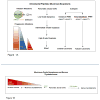Insights into the Pathogenesis of Pancreatic Cystic Neoplasms
- PMID: 28500587
- PMCID: PMC5714518
- DOI: 10.1007/s10620-017-4603-1
Insights into the Pathogenesis of Pancreatic Cystic Neoplasms
Abstract
With the current epidemic of diagnosed pancreatic cystic neoplasms on the rise, a substantial amount of work has been done to unravel their biology, thus leading to implications on clinical decision making. Recent genetic profiling of resected human specimens has identified alterations in signaling pathways involving KRAS and GNAS signaling as early events in the pathogenesis of intraductal pancreatic mucinous neoplasms. Progressively, mutations in genes such as TP53, SMAD4, RNF43, and others are thought to characterize invasive and advanced lesions. The role of inflammation in fueling the growth and transformation of these cysts has also begun to be studied with greater interest. A number of promising clinical studies have attempted to integrate these genetic insights into classifying these cysts and treating patients. We have reviewed existing literature on similar lines besides commenting on some useful animal models that recapitulate molecular and phenotypic progression of these cysts.
Keywords: GNAS; Intraductal pancreatic mucinous neoplasm; KRAS; Mucinous cystic neoplasm; Pancreatic cystic neoplasms; RNF43; Serous cystadenoma.
Figures

References
-
- de Jong K, Nio CY, Hermans JJ, Dijkgraaf MG, Gouma DJ, van Eijck CH, et al. High prevalence of pancreatic cysts detected by screening magnetic resonance imaging examinations. Clin Gastroenterol Hepatol. 2010;8:806–11. - PubMed
-
- Dudeja V, Allen PJ. Premalignant cystic neoplasms of the pancreas. Semin Oncol. 2015;42:70–85. - PubMed
Publication types
MeSH terms
Grants and funding
LinkOut - more resources
Full Text Sources
Other Literature Sources
Medical
Research Materials
Miscellaneous

